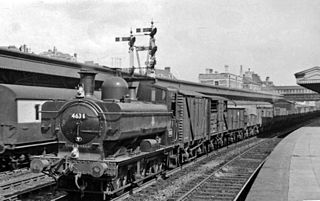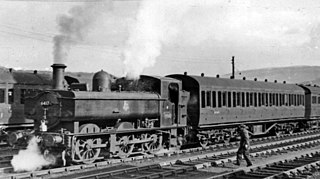
The Great Western Railway 3200 Class was a design of 4-4-0 steam locomotive for passenger train work. The nickname for this class, almost universally used at the time these engines were in service was Dukedog since the locomotives were composed of former Duke Class boilers on Bulldog Class frames. As such they were one of the last standard gauge steam locomotive classes to retain outside frames.

The GWR 5700 Class is a class of 0-6-0 pannier tank steam locomotive built by the Great Western Railway (GWR) and British Railways (BR) between 1929 and 1950. With 863 built, they were the most prolific class of the GWR, and one of the most numerous classes of British steam locomotive.

The Great Western Railway (GWR) 2251 Class or Collett Goods Class was a class of 0-6-0 steam tender locomotives designed for medium-powered freight. They were introduced in 1930 as a replacement for the earlier Dean Goods 0-6-0s and were built up to 1948.

The GWR 1400 Class is a class of steam locomotive designed by the Great Western Railway for branch line passenger work. It was originally classified as the 4800 Class when introduced in 1932, and renumbered in 1946.

The Great Western Railway (GWR) 1500 Class is a class of 0-6-0 pannier tank steam locomotive. Despite being a GWR Hawksworth design, all ten were completed under the administration of the Western Region of British Railways in 1949, just after Nationalisation.

The Great Western Railway (GWR) 9400 Class is a class of 0-6-0 pannier tank steam locomotive, used for shunting and banking duties.

The Great Western Railway (GWR) 1366 Class is a class of 0-6-0 pannier tank steam locomotives built in 1934. They were a useful design and because of their light weight and short wheelbase and were often used on dockside branches or other lines with sharp curvatures.

The GWR 5600 Class is a class of 0-6-2T steam locomotive built between 1924 and 1928. They were designed by Charles Collett for the Great Western Railway (GWR), and were introduced into traffic in 1924. After the 1923 grouping, Swindon inherited a large and variable collection of locomotives from historic Welsh railway companies, which did not fit into their standardisation programme. GWR boiler inspectors arrived en masse and either condemned the original locomotives or had them rebuilt. The systematic destruction of many examples of locomotives, most still in serviceable condition, followed, but various were worked alongside 5600 Class.

The Great Western Railway (GWR) 5400 Class was a class of 0-6-0 pannier tank steam locomotive. They were similar in appearance to many other GWR tank engines but smaller than the ubiquitous GWR 5700 Class.

The Great Western Railway (GWR) 6400 Class is a class of 0-6-0 pannier tank steam locomotive introduced by Charles Collett in 1932. All 40 examples were 'auto-fitted' – equipped with the remote-control equipment needed for working autotrains.

The Great Western Railway (GWR) 4500 Class or Small Prairie is a class of 2-6-2T steam locomotives.

The Great Western Railway (GWR) 2301 Class or Dean Goods Class is a class of British 0-6-0 steam locomotives.

The Great Western Railway (GWR) 5800 Class was a class of twenty 0-4-2T steam tank locomotives. They were built by the GWRs Swindon Works in 1933 and were used for light branch line work. They were similar to the GWR 1400 Class, but lacked the equipment for working autotrains. The last survivor of the class, number 5815, was with withdrawn in 1961. No members of the class were preserved.
The Great Western Railway (GWR) 3600 Class was a class of 2-4-2T side tank steam locomotive, designed by William Dean and built at Swindon in three lots in 1900-1903:

The GWR 1901 Class was a class of 120 small 0-6-0ST steam locomotives. Numbered 1901–2020, they were designed by George Armstrong and built at the Wolverhampton railway works, England, of the Great Western Railway between 1881 and 1895. They had wheels of 4 ft 0 in (1.219 m) diameter and a coupled wheelbase of 13 ft 8 in (4.17 m).

The GWR 2021 Class was a class of 140 0-6-0ST steam locomotives. They were built at the Wolverhampton railway works of the Great Western Railway between 1897 and 1905. 1897 was the very year of George Armstrong's retirement, so it is uncertain if the design should be attributed to him or to his superior at Swindon, William Dean.
The GWR 2721 Class was a class of 0-6-0ST steam locomotives. They were designed by William Dean and built at the Swindon Works of the Great Western Railway between 1897 and 1901.

The GWR Class 850 was an extensive class of small 0-6-0ST locomotives designed by George Armstrong and built at the Wolverhampton railway works of the Great Western Railway between 1874 and 1895. Aptly described as the GWR equivalent of the LB&SCR "Terrier" Class of William Stroudley, their wide availability and lively performance gave them long lives, and eventually they were replaced from 1949 by what were in essence very similar locomotives, the short-lived 1600 Class of Frederick Hawksworth, which in the headlong abandonment of steam outlived them by a mere seven years or so.
The GWR 1854 Class was a class of 0-6-0T steam locomotives designed by William Dean and constructed at the Swindon Works of the Great Western Railway. The class used similar inside frames and chassis dimensions to the 1813 Class of 1882-4. In this they differed from the intervening 1661 Class, which had reverted to the double frames of the Armstrong era. Thus the 1854 Class belongs to the "mainstream" of GWR 0-6-0T classes that leads towards the larger GWR pannier tanks of the 20th century.
The 4600 Class was a 4-4-2T steam locomotive built by the Great Western Railway in 1913. It was one of the GWR standard classes with two outside cylinders.

















